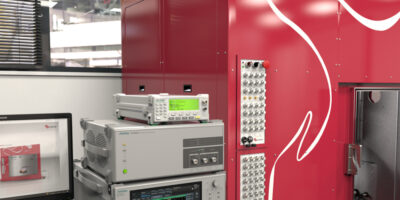Over the air (OTA) test system developer, Emite, has collaborated with Anritsu for testing the compatibility of different connection technologies such as LTE, WLAN and Bluetooth wireless technology.
The Anritsu wireless connectivity test set MT8862A, radio communication analyser MT8821C and Bluetooth test set MT8852B have been integrated with the Emite E600 reverberation chamber. The combination allows the testing of OTA / TRP (total radiated power) / TIS (total isotropic sensitivity) / TPUT (throughput) performance in a repeatable environment. With integral communications protocols and optimised performance for testing, the reverberation chamber and Anritsu platforms can reliably characterise the different co-existence scenarios of the latest devices.
In tests of co-existence scenarios of WLAN with LTE and Bluetooth technology, and LTE with WLAN and Bluetooth technology, the integration has been able to measure TRP, TIS and physical TPUT OTA performance indicators in commercially available devices.
“New features have been implemented based on market needs and working closely with our customers. Some of the leading companies in the telecommunication sector worldwide have shown interest in this solution for their OTA platforms,” said Javier Paredes, CSO of Emite.
Shinji Hoshino, Director, IoT Test Solutions Div., Anritsu Corporation, said, “IoT use cases combining several technologies are increasing, and the market requires an efficient test platform. . . . Anritsu’s long experience in bringing test solutions to the communications market will bring these benefits to the IoT test market too.”
Emite Ingeniería is a spin‐out company from the Technical University of Cartagena in Spain. It designs, develops, manufactures and commercialises OTA test systems for performance, compliance and pre‐compliance testing of any 2G to 5G standards and pre‐standards worldwide, including 5G, LTE‐A and Wi-Fi (up to 6E).
Headquartered at the Fuente Álamo High Tech Park in the Region of Murcia, Spain, it has distributors in 25 countries, test house show rooms in America, Asia and Europe. Emite OTA test systems are used by carriers, OEMs, test labs, regulatory authorities and others around the wireless ecosystem. Its MIMO OTA test systems were selected by 3GPP and CTIA as candidate methodology for the study and work items through standardisation of LTE MIMO OTA test methods.
Anritsu provides communications test and measurement products to develop wireless, optical, microwave / RF and digital solutions for R&D, manufacturing, installation, and maintenance applications, as well as multi-dimensional service assurance solutions for network monitoring and optimisation.
Anritsu also provides precision microwave / RF components, optical devices, and high-speed electrical devices for communication products and systems. The company develops solutions for 5G, M2M, IoT, as well as other emerging and legacy wireline and wireless communication markets.







